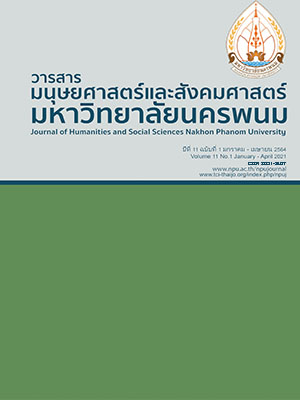Community Potential Development for Sustainable Tourism Management a Case Study of Tourism Network By Chanthaburi Community
Main Article Content
Abstract
The objective of this research were 1. To study the context tourism management of tourism network by Chanthaburi community. 2. To study tourism management participation of tourism network by Chanthaburi community and 3. To study the guidelines for the potential of tourism network development by the Chanthaburi community. The research methodology mixed. Between the quantitative and qualitative data collecting from a group of samples tourists 100 people. The tool used was a questionnaire. After that, qualitative research was conducted by in-depth interview and group discussion. With the sample group such as 14 community leaders and tourism network leaders about the potential of community development in tourism management. By using the specific random method. The statistics used for data analysis were percentage, mean, standard deviation. And content analysis methods.
The result shows that 1.The tourism management context of the tourism network by Chanthaburi community. Beginning with the problem of falling agricultural product prices Lead tourism management through research In which the community participates in management itself, focus on agricultural tourism, combined with ecotourism Including cultural tourism community traditions. Found that the sample group is satisfied with the tourism management of Chanthaburi community. Overall is at a medium level. When considering each aspect, it was found that the tourist attractions, satisfied with the tourism management of Chanthaburi community. At a high level Medium level of satisfaction were price, location, marketing promotion. In order. 2. The communities participate in tourism management that is appropriate, awareness of ownership of the area to participate in planning meetings in conjunction with the conservation of natural resources and the environment with network organizations. 3. The guidelines for the development of tourism management potential of the community, It was found that 1) Tourist attractions community is allocated The existing things are used to manage tourism to benefit. In order to impress tourists and want to come back regularly. 2) Regarding the price, adhere to the guidelines for the benefit of both the community and tourists, getting good service worth the visit In order to be a sustainable tourism. 3) The facilities are provided in various areas. To accommodate the needs of tourists of all ages, consider safety. Convenience of traveling. There is a network for cooperation in tourism management between communities. 4) Marketing promotion tourist spots are promoted through modern communication channels such as internet, websites, in order to be in line with the behavior of tourists. The benefits from the research are the guidelines for the development of community potential to sustainable tourism management by communities.
Article Details
References
Dinkhoksung, S. (2016). kānčhatkān thō̜ngthīeo dōi chumchon : kō̜ranī sưksā hāt chabā tambon chabā ʻamphœ̄ mư̄ang čhangwat ʻUbon rātchathānī. [Community Tourism Management : A Case Study of Chaba Beach Subdistrict, Chaba Sub-district, Mueang District, Ubon Ratchathani Province]. Tourism Management KhonKaen University.
Luang chan Duang. F. (2018). Sakkayaphāp chumchon tonbǣp kānthō̜ngthīeo chœ̄ng sāngsan yāng yangyư̄n [The potential of role-model communities in sustainable and creativetourism]. Ph.D. Applied Economics Maejo University.
Mathews, David. (1996). ʻongprakō̜p khō̜ng phāk prachā sangkhom thī khemkhæng læ chīwit sāthārana dān sukkhaphāp [Elements of a Strong Civil Society and Health Public Life]. Kettering Foundation. April 1996. Memio.
Ministry of Tourism and Sports. (2017). phǣn phatthanākān thō̜ngthīeo hǣng chāt chabap thī sō̜ng (Phō̜.Sō̜. sō̜ngphanhārō̜ihoksip - sō̜ngphanhārō̜ihoksipsī ) [The 2nd National Tourism Development Plan (2017-2021)]. Bangkok.
Ministry of Tourism and Sports. (2019). rāingān khāo čhāk kō̜ng sētthakit kānthō̜ngthīeo læ kīlā. [News reports from the Economy, Tourism and Sports Division] 23 August 2019.
Pinthong, J. (2014). Kān radom prachāchon phư̄a kānphatthanā chonnabot. [People Bobilization for Rural Development]. Bangkok : Odeon Star.
(Phim khrang thī 2). [Development of Thai quality of life and society indicators (2nd ed)]. Bangkok : Puangsamli, A. and Atam, O. (2016). Kānphatthanā khrư̄ang chī wat khunnaphāp chīwit læ sangkhom Thai . The Thailand Research Fund.
Suansi. P. (2003). Khūmư̄ kānčhatkān thō̜ngthīeo dōi chumchon [A guide to tourism management by Communities]. Bangkok : Tourism for Life and Nature Project.
Tourism Authority of Thailand (2017). Kānphatthanā kānthō̜ngthīeo rư̄ang konlayut kānthō̜ngthīeo chœ̄ng ʻanurak [Tourism development on ecotourism strategies]. Bangkok.
Ungjarean, R. (2017). Kānsưksā sakkayaphāp kānthō̜ngthīeo chœ̄ng Niwēt khō̜ng čhangwat samut sākō̜n [Potential Factors of Eco-Tourism in Samutsakhon]. Dusit Thani College Journal Vol.11 No.1 January-April 2017


